- All You Need to Know
Walking benefits
We explore the benefits of the simple sport of walking.
Four new studies by researchers at Harvard revealed that women who at 50-60 exercise regularly were less likely after 70 to develop
- chronic diseases
- have heart surgery or
- ANY physical, cognitive or mental impairment.
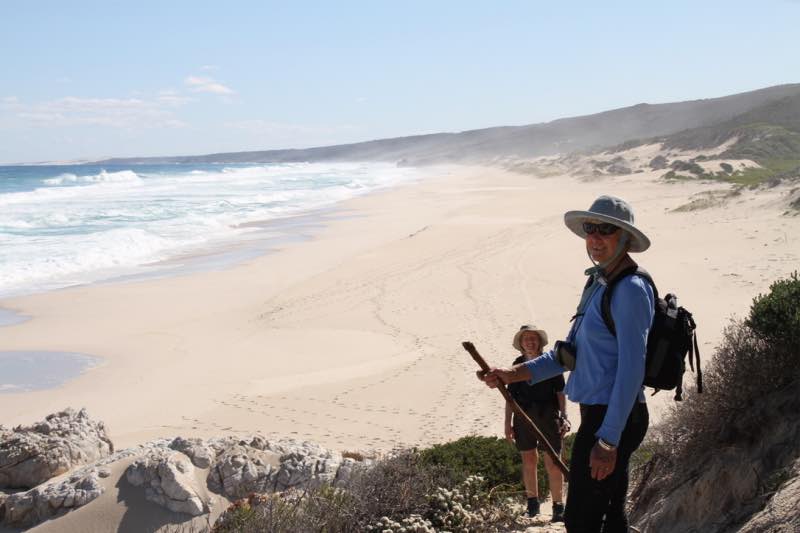
That is humungous. Less arthritis, less osteoporosis, less foot pain, less Alzheimer's, less chronic kidney and bowel disorders, and so on.
What is
more all adults, not just women, in this age group who engaged in physical exercise such as enjoying walking benefits were less likely to become cognitively
impaired that their couch-potato friends. Are you afraid of losing your
marbles? Turn off the soaps and start enjoying life yourself instead of watching others doing fun things.
Potting in the garden is of course physical exercise too.
That's where I most often escape from the stresses of the world,
enjoying a little solitude, finding God in the Garden Cathedral and
strengthening my muscles. Making compost piles is hard work!
Further still, they had denser bones, and fell less. Less broken hips, wrists, shoulders...In short, exercising regularly means not only living longer but more importantly improving your QUALITY OF LIFE.
"Nearly one quarter of Americans do not engage in any leisure-time activity."
Archives of Internal Medicine
This page was last updated by Dr Barrie Lewis on 4th March, 2022.
New research released in 2020
The average Western person takes about 3,000 to 4,000 steps per day; that is a bit under two miles. It is generally considered too little. Researchers commenting in JAMA, after following a group of US adults aged 40 and over, found that increasing that to 8,000 strides, an extra two miles, reduced death from all causes by a massive 51 percent. That would take about half an hour.
And an extra four miles brought even more benefits[1]. Interestingly how fast you walked made little difference. And it not only reduced diabetes and heart disease, but also some malignant tumours.
Must it be this kind of a hike? Nope, but this is what walking means for some.
These two hikes along the Whale trail in the Southern Cape and to the top of Rhino Peak in the Drakensberg mountains stretched me, but what powerful walking benefits that remain long after the ventures. It makes a lot of sense going out where it is pleasurable, rather than along a road with endless passing traffic.

For the privileged few there is a hike through the famed Kruger National Park with a guard, rifle in hand, just in case; walking benefits abound. It could be you, if you pay a visit to South Africa.

Be sure to include a
hike a in the Drakensberg Mountains. No where can you find a friendlier
welcome than at the Antbear Guest House[3]. In fact, they'll organise your SA
sightseeing trip for you. Lots of walking benefits. Just Google them.

"Few people know how to take a walk. The qualifications are endurance, plain clothes, old shoes, an eye for nature, good humor, vast curiosity, good speech, good silence and nothing too much."
Ralph Waldo Emerson, 1803 - 1882
Walking benefits
Walking benefits does for exercise what the human voice does for the orchestra; it is the simplest and most profound instrument of your repertoire.
Nope, not Everest, not the South Pole, just a lovely stroll in the park every day.
Or, around the block at lunch time, apple in hand?
A good hike around the arboretum at the weekend? Along the beach? In the hills? Do your thing. But do something.
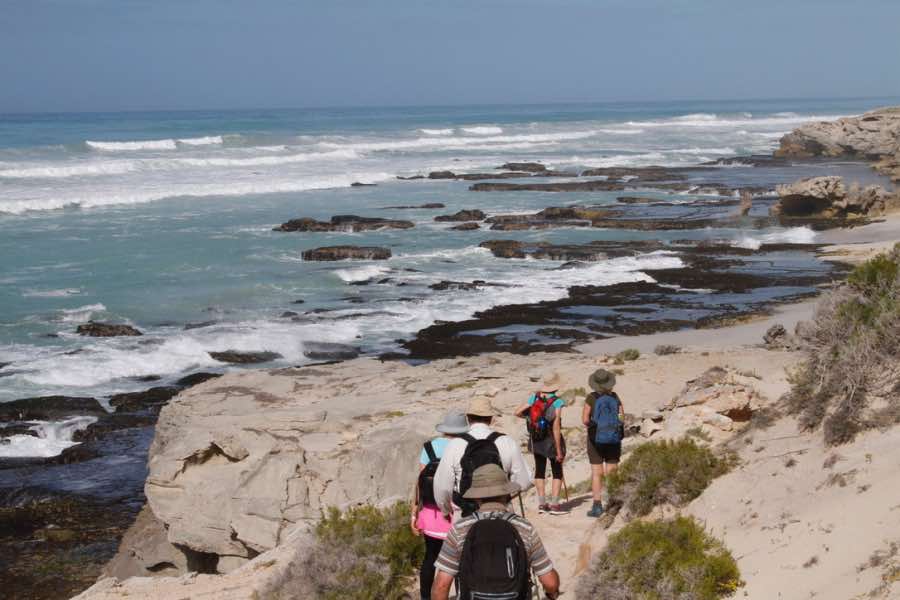
Restore human legs as a means of travel. Pedestrians rely on food for fuel and need no special parking facilities.
Lewis Mumford, 1895 - 1990
For me walking does what most other sports cannot do. It gives me space to explore my whole self; body, mind and spirit. What other games can you enjoy and, at the same time, think, sing or pray?
Why is all this important for the chiropractor? After your injury, be it an ankle, a low back or a hip or any other, of course, your exercising will have to go back to square one. The snakes are grinning, but wait, with the right ladders you will eventually sully forth from that horrid pit of despair that has accosted you; if you will give your injury time to heal, and do the correct rehabilitation.
It's a great challenge for the chiropractor to motivate the athlete with a torn hamstring, or the elderly woman who has broken her hip, to start with walking after injury, or face again damaging the part, and months of extra rehabilitation.
It has been said that it is not how far you traveled, but how much you saw and heard and smelt and felt along the way that really counts. Nowhere is that more true than on Shanks Pony, and to a lesser extent the bicycle. Time to pick a few wild cherries growing beside the road, save a lonely toad from a hole or watch an eagle soaring a thermal.

Ever tried gliding? Want to fly? That's not so preposterous as you might
think, and not as expensive either. Soaring with eagles (literally) is
one of the most sublime experiences of a life time. If you are tiring of walking benefits,
take a break down this little alleyway. Remember to come back, hey!
I'll be waiting to tell you about the benefits of walking on your
cholesterol levels.

Walking and Alzheimer's disease
Alzheimers is a progressive disease in which a protein called amyloid plaque is laid down in the brain. The brain actually shrinks in size, as seen on an MRI scan.
This is a complex disease, but quite a lot is known about it. Including that a walk every day actually causes the brain to INCREASE in size. It is a greedy organ, requiring prodigious amounts of fully oxygenated blood.
More exercise > Increased blood to the head >> more oxygen >>> bigger brain, literally.
The jury is out: Walking reduces the incidence and seriousness; Alzheimer's and exercise are intimately connected. And of course remember to feed the second brain with a probiotic like kefir on a regular basis.
ALZHEIMER'S TEST
Take the one minute test. You will need a second person to count for you. Can you name more than 20 kinds of fruit in one minute. And secondly, 20 animals?
Less than 10? ... you had better start walking! Read more at Past issues about the Alzheimers test.
- Walking and cholesterol
There are two main forms of cholesterol, one dubious and which should be kept low ("low density") and the other health- and life-giving (called "high density") and which should be raised as much as possible.
Most cholesterol pills (statins) lower both lower both the LDLs AND the friendly HDLs. Walking lowers the bad LDLs, but raises the good HDLs. For more about cholesterol, click here: CHOLESTEROL ALCOHOL ...
- Walking and Diabetes
A recent study found that people with adult-onset diabetes who walked four kilometres a day lost weight and lowered their heart rate, blood pressure, cholesterol and triglyceride levels.
What's more, it proved twice as effective for lowering blood glucose as following a stringent diet regimen. Read more about diabetes and fitness …
My own blood glucose soars if I drink a glass of freshly squeezed orange juice, but just following it with a ten minute slow walk cum jog and there is no abnormal rise.Plantar myofascitis
Plantar myofascitis can certainly rob you of your walking benefits.
From the Coalface Charcot foot
A mister Hardeman* has been consulting me recently concerning pain in his left foot. What is unusual is that he is 87 and has been injecting himself with insulin for over 50 years.
'When did the pain start, Mr Hardeman?'
'About two years ago.'
'Did anything happen?'
'Not that I know of. My wife and walk about five kilometres every day - I have done ever since I was diagnosed with diabetes. About two years ago is started hurting after our walk. Walking is very painful now.'
I put the CD with the x-rays of his foot into my computer and had to suppress a little gasp. The arch of his foot has collapsed completely, and there is advanced change in the bone structure associated with a condition called Charcot foot.
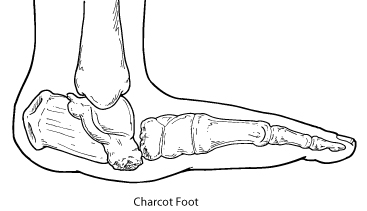
Not many men have the privilege of living to 87, and extremely few diabetics. Mr Hardeman has enjoyed a long and full life, despite his diabetes, because of the habit endowed by a wise doctor who knew all about walking benefits whilst Mr Hardeman was still a young man. But now, finally his diabetes has finally caught up with him, by the looks of things.
Charcot foot (diagnosed by the radiologist) is caused by a serious softening of the bone in people with a neuropathy - and diabetes is king of the nerve diseases - blindness and weakness of the muscles, bones too. But wait. Did he have the other signs of a Charcot foot?
'Please remove your shoes and socks, Mr Hardeman. Let's have a look.' It didn't take me long to confirm that there was no warmth, swelling or redness, the cardinal signs. However, I couldn't feel the pulse behind the ankle bone, or on top of the foot. What was very evident was joint fixation in what is called the 'subtalar joint' and in the midfoot, and a plantar myofascitis ... 'Encouraging news, Mr Hardeman. I think I may be able to help. I'm not making any promises but ...
The long and the short of it was that after only one treatment, he declared that the pain was 40% less, and could he start walking again? I wasn't really treating the disease, but a chiropractic problem in the foot that anyone, with or without diabetes can get.
All the walking benefits have saved him from the devastating effects of diabetes, but ultimately the softness of the bones associated with the diabetes had caught up with him. We've got him walking in soft shoes, on firm lawns, and today he is very much alive and walking. At 87 I find him an inspiration, a man who has conquered the most feared of diseases by his disciplined walking, a real tribute to the power of persistence.
Causes of osteoporosis
Causes of osteoporosis and walking benefits are intimately entwined.
- Walking and Osteoporosis
There is overwhelming evidence that children, particularly girls, and women of ALL ages should be participating regularly in walking benefits to prevent osteoporosis. Waiting until you are old and grey to start exercising your bones is a recipe for disaster. For more details about the CAUSES OF OSTEOPOROSIS ...
Medication is not the solution; this Fosamax reviews makes scary reading; the drug makes heavier, more calcium dense bones, BUT increases the likelihood of hip and jawbone fracture.
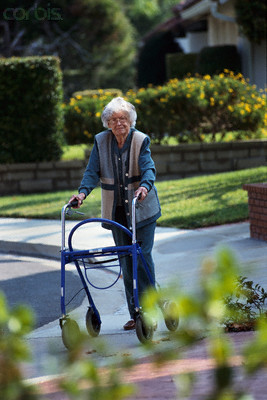
Yes, she is walking too. Good for her. You might think the walker just the most awful thing that could happen to you. Would you rather drop dead of a heart attack at 58?
Walking and depression
Deep inside the brain is a very tiny but so important gland called the Pineal. See it in the pic? This little gland controls your waking and sleeping through a hormone called Melatonin.
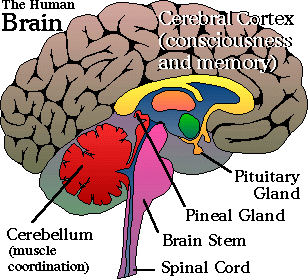
The walking benefits (in sunlight) have now been abundantly demonstrated scientifically, but even the ancients knew about it. Just look at this beautiful depiction of the Pineal gland by Descartes.
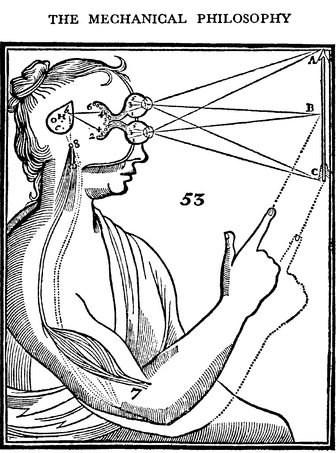
Light entering the eyes sends not only images to your visual cortex (where you "see" things) but also to the Pineal gland where it is stimulates the secretion the feel-good hormones.
Turn off the light and your Pineal puts the body into sleep mode. During the day, that's called depression. One of the first steps back on the road to recovery is a daily walk in bright sunshine.
It's no coincidence that levels of depression soars in the long winter months in countries far from the equator. It is called Seasonally Affected Disorder or SAD. The solution is not pills, but a good walk.
Walking benefits abound.
For more about simple
things you can do for depression, read this short medical
report.
Natural relief for depression from Johns Hopkins medicine makes
interesting reading; there are alternatives to drugs.
Walking and weight loss
May I be honest? If you want to lose weight primarily through hiking, you've got your back up against a wall. This is not one of the walking benefits. To lose one miserable pound a week you have to take an extra, over and above what you normally do, brisk stroll for an hour and a half every day. Have you got that much time and discipline?
The big plus of course is that you will improve your muscle tone, decrease the likelihood of osteoporosis, and be a lot more mentally relaxed, so I am not pouring cold water on a long walk every day. Just I don't think most obese folk will manage it.
And the downside if you are seriously overweight? Sore feet, no time for other, less important things, it's true, and the sneaky feeling that you won't keep it up. It's just over the top.
You could instead, of course, take a fast one hour bike ride or swimming lengths in the pool.
Done every day, seven days a week, and you will lose one pound. That's assuming you don't eat more, 'cause you're going to be starving.
Negative? Not really, as a chiropractor I am totally in favour of more exercise. It will do you a power of good, but as a weight loss technique, walking benefits is a dead loss. Much better, consider our free weight loss programs, eat more sensibly and take a regular reasonable hike that you know you can manage and keep up.
For more about our FREE WEIGHT LOSS PROGRAMS ...
Walking and breast tumours
No one is quite sure why, but women who exercise regularly have a lower rate of serious breast disease. That's just another good reason to enjoy walking benefits.
Those who breastfeed their babies too have less mammary gland tumours and their children are more intelligent.
Right now I'm treating two Dutch women whose daughters, in their thirties, have malignant breast tumours. One is terminal; both have children under the age of two. Does it only happen to other people?
"Mum, do you know the Rule of Three for colicky babies?"
You may be putting up with that all that screaming for nothing. Read more at COLIC CHIROPRACTIC
I could list another thousand walking benefits. The unforgettable memories of my last holiday, hiking around Schwendi in the shadow of the North Face of the mighty Swiss Eiger; a hundred kilometre trudge along South Africa's Wild Coast
If we want to be happier, healthier and even perhaps meet with God we should try a little walk; regularly. And occasionally a really long hike.
Walking benefits are sublime.
"If a woman rebels against high-heeled shoes, she should take care to do it in a very smart hat."
- George Bernard Shaw
Leg length inequality
If one leg is shorter than the other it will affect standing and especially make strolling slowly (as in shopping) difficult. It also causes a greater likelihood of hip arthritis. Get a heel lift of the right size from your chiropractor.
Ask them about leg length inequality.
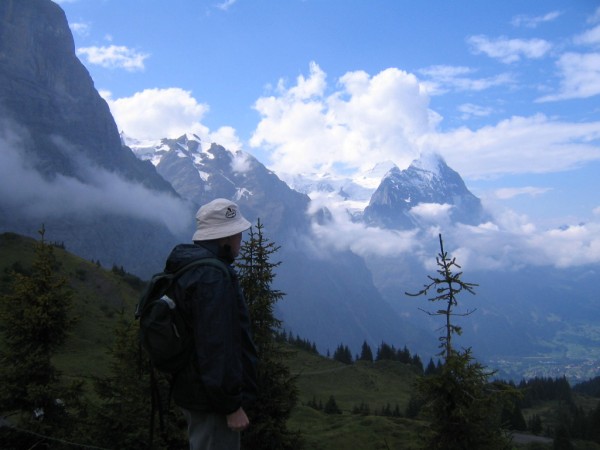
It's now ten years since we enjoyed this holiday in Svendi. I expect you can guess which country it is in. I still have that hat, but it is very tatty and only allowed in the garden. Chiropractors, even those that are semi-retired have to remember that they are doctors and expected to look the part.
Walking speed
Research shows that if you train yourself to walk faster, and deal
with the problems (like foot pain ) that might slow you down, you will add
years of life... quality years too.
The ten second step test may give an indication if there's a neurological cause of difficulties with walking. Is your gait poor? Are you starting to fall?
Walking speed is vitally important.
Heel spur
Do you have severe pain under your heel, primarily when you get up in the morning? You may well have a heel spur; it's a part of a chronic plantar myofasciitis, mentioned above, which originates from the heel bone. It can certainly in the short term prevent you from enjoying walking benefits.
Don't let anybody cut it off! The pain will go away when the cause, usually a fixation in one of the ankle bones, is addressed. A heel cup may help for a couple months. Two actually, as you have to wear them in both shoes, or you'll give yourself a painful back from a short leg.
USEFUL LINKS
- Chiro management of FOOT PAIN ...
- A three minute test of your general level of fitness. KASCH PULSE RECOVERY TEST ...
- Knee pain and walking. A simple test for kneecap arthritis. CLARKE'S TEST ...
- CHIROPRACTIC HELP Questions ... by all means submit a query ...
When browsing these links use right click and "Open Link in New Tab", or you may get a bad gateway signal.
- Home
- Walking
Did you find this page useful? Then perhaps forward it to a suffering friend. Better still, Tweet or Face Book it.
